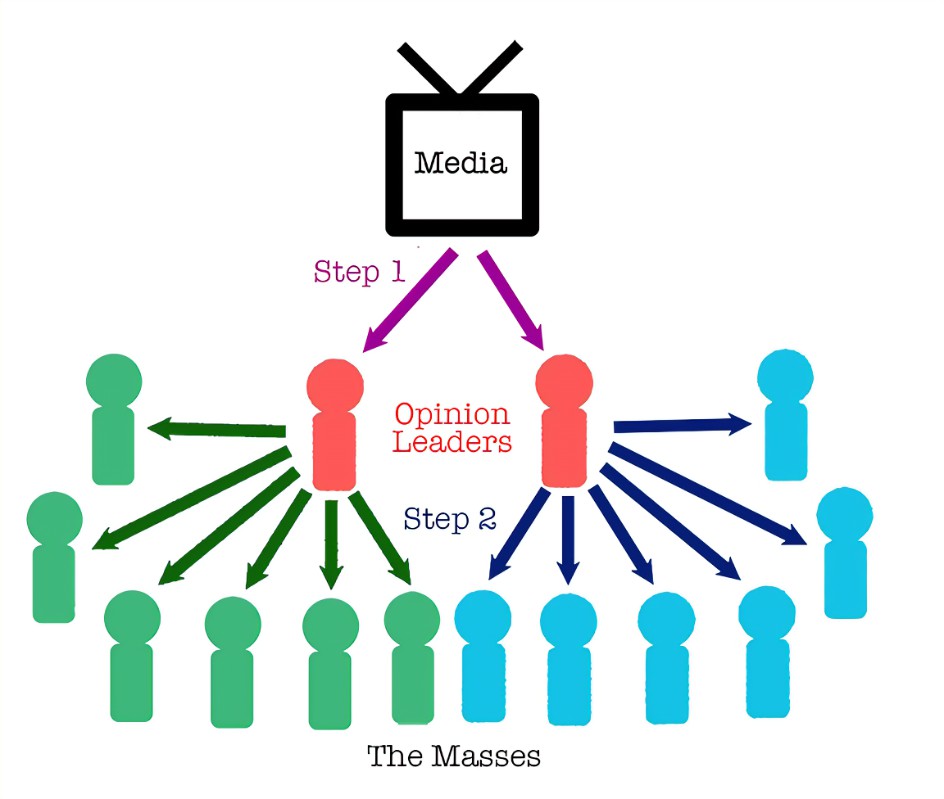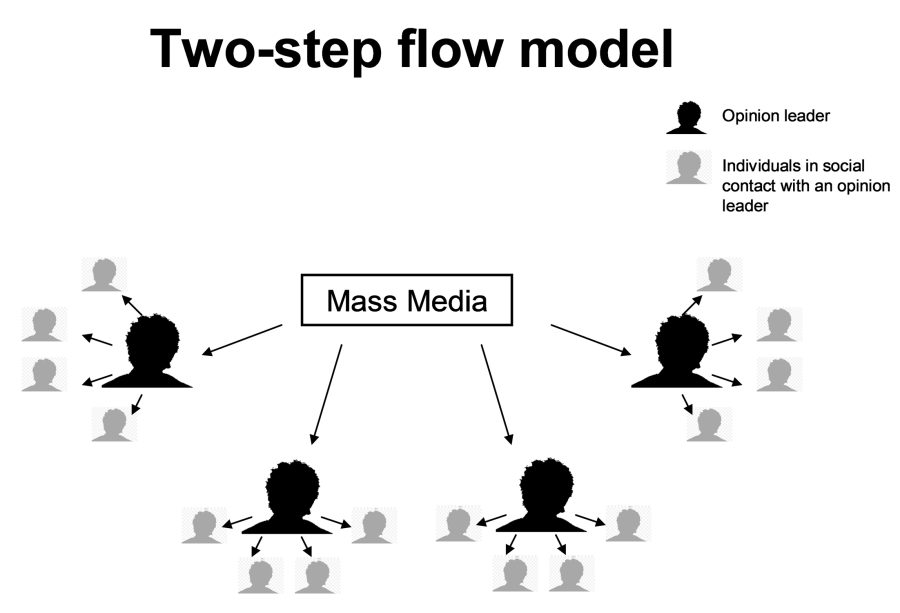How the Two Step Flow Theory began
Paul Lazarsfed introduced the Two Step Flow Theory in the 1944. When there was presidential election campaign over in the States, researchers looked at people’s decision processes. The Two Step Flow Theory has stages going from mass media to opinion leaders. The theory is for people who engaged with the media and pass it on to the population. According to (Rane, 2022) states: The role of the two-step theory is made up by opinion leaders who absorb the information and pass it on the rest of society. They act as the middleman giving their opinions interruptions. For example, media houses can pass on information to the middleman which then go onto larger audiences.
Diagram of Two Step Flow theory

Advantages of the Two-Step Flow Theory
(The Two Step Flow Theory Explained 5th April 2019 ) explains how the theory is aimed for an active audience and people who consume different mediums that create interaction such as radio, tv and social media.
A good example of how the Two-Step Flow Theory can work, if someone like Katie Price who is known as a big star has a load of followers on social media and there’s a new makeup product coming out they do a video on the product and promote it. The advertising company will ask the person with loads of followers to do a video about make up, as most of their audience will buy it as they are loyal to them.
Disadvantages of the Two-Step Flow Theory
The Two Step-Flow Theory can also be seen in other mediums like television. (Two Step Flow Theory: Media Theories, 2020) talks about how the Two-Step Theory is used in television. In today’s world, we have a lot of fake news and mistrust of the media. This allows opinion leaders and influencers to take news from the mass media they believe in and feed it to the audience. An example of this is the television show last Week Tonight by John Oliver.
All these shows that talk about politics and discuss about the world today. They can talk all the information there getting from the media and tell their viewers. Viewers can accept the media or turn off to a different show.
However, there are disadvantages to the two-step flow theory. The first disadvantage is the limitations to it. If someone gets information from an opinion leader and diffuses it to someone else. This can cause diffusion of information and how people’s social media can destroy users personal experiences though using social media.
Personalisation is all about tailoring experiences to users. These days users can choice what platform they get their content from and how they receive information. (Soffer, 2021) states in their journal article it seems the algorithm knows the users and their tastes continues and strengthens trends in traditional mass communication: to give the audience the feeling of being personally addressed by the mass media. Over the years digital technology has changed the way we consume information on social media platforms. (Soffer, 2021 cited in Karlsen (2015) the diffusion of content in social networks depends on active users, such as opinion leaders. Thus, the logic of diffusing content from active leaders to more passive individuals resembles the diffusion both in the two-step flow and in social networks. Though the use of algorithms and platforms opinion leaders can generate fake news and people can be influenced by what they see. For example, someone brings out a product on make up people are likely to believe the active leaders more than they would do passive leaders who would read things about it first before posting on social media.
Another disadvantage is people may not be relying on information, facts and more of opinions they trust. So they may not be getting accurate information. The theory has been criticised by critics for oversimplifying the relationship between media and audience. However, the big criticism for me is the two step flow theory was introduced in the 20th century, when radio and newspapers were known as mass media and dominating channels. These days we can personalise content and make our own choices so is it really needed in 21st century?
References
Rane, I. (2022) Two-Step Flow of Communication Theory: Simple Explanation, Sociology Group. Available at: https://www.sociologygroup.com/two-step-flow-of-communication/ (Accessed: 25 November 2024).
Two Step Flow Theory Explained | Media Studies (2019). Available at: https://www.youtube.com/watch?v=jimZErv1Ohw (Accessed: 26 November 2024).
Two Step Flow Theory: Media Theories (2020). Available at: https://www.youtube.com/watch?v=oGJi9KbQYiM (Accessed: 26 November 2024).
Soffer, O. (2021) ‘Algorithmic Personalization and the Two-Step Flow of Communication’, Communication Theory, 31(3), pp. 297–315. Available at: https://doi.org/10.1093/ct/qtz008.


I enjoyed reading your blog post on the Two-Step Flow Theory. I liked the way you addressed its historical context and explaining its evolution in today’s media landscape. The examples you provided, particularly regarding the influence of social media opinion leaders, were helpful to fully understand the theory and they were relevant. I also liked that you included a diagram as it made it easier to understand the theory by having a visual representation.
I found it particularly interesting how you highlighted the limitations of the theory in the face of misinformation and the complexity of modern digital interactions. It would be interesting to see further exploration of how this theory might be adapted to address the nuances of personalised content and algorithm-driven platforms. I also think it would be nice if you made the headings a bit bigger and made a stronger demarcation between the text and the reference section at the end.
Overall, I found your blog post to be very clear and interesting to read.
Thank you very much I have taken you comments on board and talked about what you said in my blog.